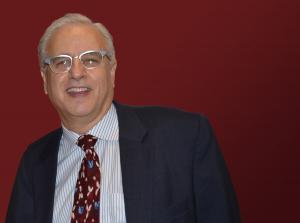Should We Lift the Curtain?
Steve Mitnick is Editor-in-Chief of Public Utilities Fortnightly and author of the book “Lines Down: How We Pay, Use, Value Grid Electricity Amid the Storm.”
Thomas Edison and George Westinghouse founded the electric utility business model in the late nineteenth century. Edison’s onetime secretary, Samuel Insull, refined the model in the early twentieth century. Spurred on by Insull, the Wisconsin Public Service Commission started regulating utilities.

This was a hundred and ten years ago. Our business model is that old.
Is it enduring? Or, as some commentators have asked, on the pages of Public Utilities Fortnightly, is it outmoded?
The initial approach of Edison and Westinghouse, though as rivals, was to sell distributed generation to those with means. Sell the wealthy a generator. Install it on his ample premises. Wire up the stately home. Done.
Seems simple. But electricity, whether home or locally brewed, is hardly simple.
Perhaps only Edison and Westinghouse knew better in those first days. Perhaps only they saw that the inherent complexity of electricity could keep it from becoming our society’s lifeblood, if consumers were left to cope with the complications.
This problem really bothered Westinghouse. He literally obsessed about it. He and Edison soon followed suit.
The two of them understood the difference between electrical capacity and energy. And pondered the implications of electrical energy’s instantaneous nature.
They tirelessly tested batteries. They understood the fundamental electrochemical inefficiency of storage from constant charging and discharging.
They understood that demand for electricity cycles up and down, instantly and erratically. That it’s tough enough to deal with when demand’s fluctuations are from lighting. And that it’s especially tough to deal with when demand’s fluctuations are from machinery.
They understood the challenge of consistent reliability over long time periods of many tens of thousands of hours. And resilience through all the harshest environmental conditions.
Electrical equipment not only wears from continuous operation and weather. It requires skilled maintenance. Eventually it becomes obsolete as new equipment becomes commercial.
They knew electrical equipment required upfront capital, a lot of it. The capital intensity problem was among the challenges they fretted about the most.
They understood the dangers if the highest standards of safety weren’t strictly followed. They thought of electricity as a formidable force that must be contained and channeled. They witnessed the horror when it wasn’t.
If Edison and Westinghouse had continued distributing generators (and had not switched to distributing electricity), the complexities would have become apparent to all of the public. But, instead, our industry’s founders switched gears. Pun intended.
In establishing our utility business model, they quite intentionally hid electricity’s complexity from the consumer. The cloaking was made possible by selling kilowatt-hours rather than generators.
Only those who could afford an army of servants and workmen could have coped with the complications. And fewer would try. Our founders knew this.
The working class would never realize electricity’s bounty. Those renting farms, houses and apartments. They would have been left behind.
To our founders, this was an abhorrent scenario. Like Steve Jobs in our day, they drove themselves and their teams, drove them hard, to make their inventions universal, to change the way we live.
So over ninety-nine percent of our electricity is produced by a virtually invisible utility network. Just four tenths of a percent of our electricity is produced, notwithstanding all the buzz, by quite visible distributed generators.
Electricity from the utility network is handed to us on a silver platter. We receive it effortlessly.
What did it take to get the electricity here? Nothing for you to be concerned with.
Was it difficult or was it easy? Not your worry.
Electricity from the utility network has a footprint, sure. But it’s over the horizon.
This is why apartment dwellers can have what mansion millionaires have, when it comes to electricity. Both are electrified the exact same way, by an innocuous wire to a home.
It was Samuel Insull that insisted utilities be regulated. Why? Why did he risk his industry standing for what his peers saw as a foolish quest? A lonely eight-year campaign at the beginning of the twentieth century.
Insull too wanted to ensure the universality of electric service. He fervently believed this could only be achieved if every economy was captured, if capital’s risk was minimized, and if the resulting costs were broadly socialized.
With all our technological advancement, with electric service having become universal long ago, are Insull’s laws less applicable today?
If every economy isn’t captured, if capital’s risk isn’t minimized, if costs aren’t broadly socialized, can electric service remain universal? Or is it inevitable there will be haves, of reliable electricity, and have-nots?
The complexity of a utility network, regulated by the public’s representatives, ultimately becomes opaque. Though its costs are transparent.
The network’s footprint has moved further and further from view. After 9/11 and the emergence of new security threats, the network’s locations have disappeared from maps, substation walls have become higher, and photography of the infrastructure rarer.
Very few people see the network’s generators or notice the network’s substations and lines. More than ever before, the network is an abstraction.
The popular perception is that the infrastructure is more characteristic of mid-twentieth century industrial America than of today’s tech society. Almost nobody realizes the most advanced technology helps us manage grids, operate plants, integrate renewables, route flows, limit peak demand, and restore service after storms.
Should we lift the curtain covering the network’s complexity? Edison, Westinghouse and Insull would blanch. But they needed to spread electricity’s bounty. They needed to encourage adoption of electric service.
At this point in our industry’s history, the imperative is to maintain electricity’s bounty. We need to encourage support for electric service.
Our industry’s founders developed timeless principles we’ve followed and shall follow going forward, in the public interest. But we should perhaps tweak one of their principles. We should perhaps raise the curtain.



